#cube shape pyrite
Text
#gemstone bracelets#gemstone lot#gemstone beads#gemstone necklace#gemstone ring#gemstone jewellery online#gemstone#gemstone jewelry#gemstone pendants#gemstone stim#cube shape pyrite#pyrite gemstone#pyrite bracelet#beads bracelet
0 notes
Text
i actually would make fancams for gemstones if i had any real video editing skills. i want a pyrite one. cube fancam
#me a week ago infodumping to my parents at 10:30 pm: and the way crystal structures work is that the patterns are repeated down to the#atomic level and so when you see a pyrite cube that means that it's actually a billion million little cubes all stacked together to make#one big one and if you break pyrite it breaks into cubes like it's perforated that way because all the atoms in it are also in cube shapes#my mom and stepdad: well we're just glad you're having fun sweetheart
17 notes
·
View notes
Text
Gem placement is hard [dies]
#lucifers was easy!! he already has a diamond on his forehead!!#satan makes sense to have it on his neck/clavicle bc of his design im doing#i just put mams on his chest bc fsr gems have to be showing at all times so i cant give him pyrite fangs ( ˘ ^˘ )=3#also its a massive cube and needed to go somewhere#beels is probably gonna be on his stomach#belphies on his lower back to parallel beel#asmo is probably gonna have a heart shaped gem maybe on his chest or clavicle so its generally where hearts go#i have no fucking clue where to put levis#his hand?? under his bangs???#man i dunno#dias is 100000% going smack dab in the middle of his chest bc 1. obvious reasons look at him but 2. bc i think itd be funny#to have an eye in the middle of his chest like [. ](|)[ .] KFBSSKD his gem is tigers eye idk if i mentioned that#ough coming up with placements AND shapes for all these guys is gonna kill me#i have 0 clue where to put el's either. i initially thought hey what if its on his back showing that he's strong & a good defender#but at the same time too trusting and could easily get stabbed in the back *cough*L16*cough*#which is good!! i like it but also no gem in SU has that im pretty sure. and that means id usually never get to draw his gem which is sad!#also i have to think abt smooth vs faceted gems and how that effects the placement and coloration#[dies]#elliot doodles#obey me
6 notes
·
View notes
Text
Let's Talk Pyrite Disease
Okay. Pyrite is amazing. Pyrite, or fool’s gold, has a simple formula (FeS2), forms beautiful cubes, and has all sorts of cool features. I'll talk later about how iron minerals can move and change and how they're related to theories about cells, but first, let's talk about Pyrite disease.

Image ID: Several pyritized ammonite shells in various stages of decay. They all have a light-grey color and a velvety appearance. There are a few in the center that are severely decayed and appear to be just a pile of dark grey and yellow dust, with a similar appearance to mold. One ammonite in the top-center is a more gold-brown color and has cube-shaped pyrite crystals on it. End ID.
[Image by https://twitter.com/MSidKelly/status/667548523475288064]
TLDR: Pyrite disease is a form of rust that impacts pyrite. It produces iron oxides, sulfuric acid, and sulfur dioxide, damaging mineral specimens, fossils, and storage materials. It causes expansion and acid damage that cracks and erodes specimens.
oh and @simple-potato-farmer, @team-clockers, @edthefatmagicturtle, y’all expressed interest in this so here you go! warning: it’s 10 pages long
How Can Fossil Come in Contact with Pyrite?
Pyrite is the most abundant sulfide mineral. Pyrite is found in quartz veins, coal mines, sedimentary rock, metamorphic rock, and in fossils as a replacement mineral. Pyrite forms in anoxic environments, which makes it a good environmental indicator. It also means that pyrite is found in association with many deep ocean fossils.
Fossils can be replaced by pyrite. This happens in a process called pyritization, a form of replacement diagenesis where the original material of the organism (in some cases, even soft parts) is replaced by pyrite. For instance, due to the anoxic and high-sulfide concentration in the deep ocean, calcite shells may be replaced by iron pyrite. This is aided by the presence of sulfur-reducing bacteria that facilitate the creation of iron sulfides, and therefore facilitate the precipitation of pyrite during decay(1) as sulfides are produced by the decaying organism(2). In a unique case, high microbial activity led to documentation of pyrite formation on the shells of living mollusks(3). This process leads to beautiful pyritized fossils that look like metal casts but actually are the fossil completely replaced by pyrite.

Image ID: An ammonite cut in half to show pyritization. The entire ammonite appears metallic gold, and the internal cavities contain fine drusy pyrite crystals. End ID.
[Image by: Replacement/Recrystallization (petrifiedwoodmuseum.org)]
Not all fossils end up beautifully pyritized, and not all pyritized fossils stay that way. Pyrite disease, also called pyrite oxidation, pyrite rot, or pyrite decay, is a form of rust. Millions of years of history, only to be destroyed by poor archiving, humidity, and pyrite decay.
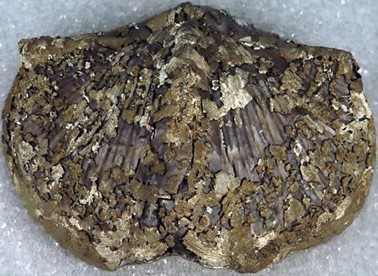
Image ID: A brachiopod specimen with pyrite replacement and a patchy outer coating of pyrite. Unlike the ammonite, the pyrite has grown over the shell of this brachiopod in addition to replacing the original structure. End ID.
[Image by: jsjgeology.net/Replacement.htm]
What does Pyrite Disease Do?
Since pyrite is formed in anoxic conditions, most pyritized specimens remain stable for a long time. The reason we observe so much pyrite decay in museum settings and other fossil collections is because the specimens have been removed from the rock and sediment that were limiting their exposure to oxygen. Pyrite decay can occur with or without water, but when pyrite oxidizes in humid air, it reacts with both oxygen and water. This creates not only iron oxide ‘rust’, but also iron sulfate, sulfuric acid, and sulfur dioxide gas4 (corrosive and toxic materials)(1). This chemical reaction eventually destroys the specimen through a combination of factors. The sulfuric acid is corrosive and damages the specimen. Oxidized pyrite is unstable and may crumble over time. There is also another damaging factor: the risks of pyrite replacement and iron sulfate production.
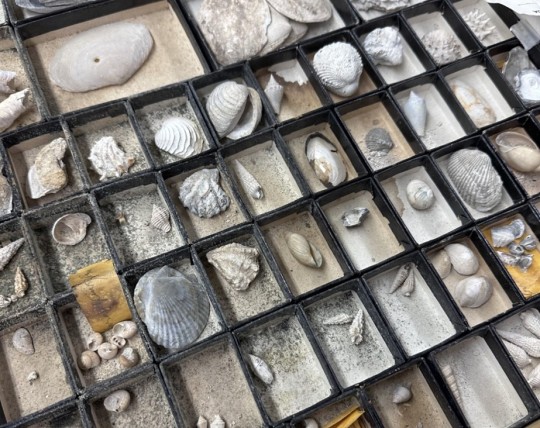
Image ID: A tray of mollusk fossils, each with separate boxes, with evidence of pyrite decay. There is dark grey dust in the bottom of most boxes, and a line of what appears to be water damage across the boxes. The apparent water damage is the result of the sulfuric acid produced. It has also discolored fossils and their labels. End ID. [Image by me]
Pyrite disease is a progressive process that affects fossils over time. Many pyritized specimens may last for years in perfect condition, while many others progressively decay from undetected pyrite disease. The reason that pyrite replacement is notorious for decay has to do with the crystal structure of pyrite. The famous cuboid structure of pyrite crystals is the most stable form of pyrite(4) since the compact form does not easily absorb moisture. Pyrite may occur in a compact, crystalline, stable form or a porous microcrystalline form that is unstable. Certain formations produce more stable pyrite with fewer impurities, but certain fossils are also more susceptible to unstable forms of pyrite. Marcasite is a less common dimorph of pyrite that is more unstable(5). Ammonites, especially those from the Charmoth clays, are notorious for pyrite decay while South American specimens and Yorkshire coast fossils are much more stable(2). The iron sulfate that is produced by the oxidation process is considered an efflorescent mineral(5), a term that means “flowering.” This is because this material has a higher molar volume (the ratio of the volume occupied by a certain amount of a substance) than iron pyrite and wedges the specimen apart as it expands past the constraints of the original crystal structure(5).
Unfortunately, the creation of efflorescent minerals, including other hydrous sulfate minerals, creates a feedback loop. These materials produce acids and provide water that causes the pyrite to further decay, producing more Fe3+ and more efflorescent materials, which feed the cycle of oxidation(5).

Image ID: Two images of the same pyrite disk, taken two years apart. In the left image, the disk has a few cracks and white discoloration in the center, with a yellow outline around the discoloration from sulfur. In the right image, the disk is shown two years later, cracked into four large pieces. The discoloration now extends almost to the edges of the disk, with a much larger yellow margin. End ID.
[Image by Ed Clopton, General: Need 'Pyrite Disease' Photos (mindat.org)]
(For an interesting, related topic – pyrite decay is a risk in coal mining for a multitude of reasons, including the increase of pulmonary and respiratory disease after pyrite inhalation, the risk of silicosis, and the risk of spontaneous combustion caused by the exothermic reaction involved in the decay of high-sulfide deposits.)
What Does Pyrite Disease Look Like?
Pyrite disease may appear grey, greenish, black, red-orange, white, or sulfur yellow. A redder color indicates rust from other iron minerals other than pyrite. Since pyrite contains sulfur and pyrite oxidation produces sulfuric acid, it may have the rotten-egg smell often associated with sulfur. A metallic-iron smell may also be present. Inhaling the result of pyrite decay can be hazardous (in my experience, it caused migraines even when I double-masked before entering the room due to the severity of the condition of our collections. In most cases it is much less of a concern). If pyrite disease is found, wear gloves and masks and try to disturb the dust as little as possible. Remember that pyrite disease is worse in humid conditions, and these same conditions may encourage the growth of mold. The early stages of pyrite disease may appear as spots of discoloration on a fossil, a slightly duller appearance, additional crystallization, or cracking. Often, the first noticeable sign that is clearly identifiable is dust in the bottom of the box the specimen is in. In these early stages, the severity of the pyrite decay may not be detected until the specimen is moved or handled, and subsequently begins to crumble or leaves dust and a metallic smell on your hands. Later stages appear like mold and may have a fuzzy, cloud-like appearance. If you handle a specimen with pyrite disease, take care to wash your hands and dry them well before handling any other specimens, and check the container or the contaminated specimens and those that surround it so that they can be replaced if needed. In the worst stages of pyrite decay, what is left is not a fossil that may crumble if handled, but a pile of dust. Pyrite disease can affect vertebrate fossils, invertebrate fossils, botanical specimens, mineral specimens with pyrite, and the containers and shelving used.
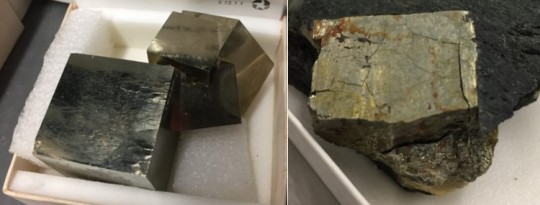
Image ID: Two images of cubic pyrite crystals. Left: Four cubic pyrite crystals growing into each other, they are a solid metallic gold color with few visible imperfections. Right: a cubic pyrite crystal in a dark matric. This piece is affected by pyrite decay, and the cubic shape is no longer perfect due to cracks in the specimen. It has orange and yellow sections that appear like water stains due to the sulfuric acid produced by pyrite oxidation. End ID.
[Image by Pyrite Disease - Canadian Museum of Nature]
Why Is It A “Disease?”
If the damage to the fossils themselves was not bad enough, consider another factor: it’s often called pyrite disease, instead of pyrite oxidation, for a reason. That reason is that pyrite disease spreads and progresses over time. Historically it was thought that this was the result of a bacterial component, and it was even recommended to treat fossils with antibacterial ointments(5). While bioleaching of pyrite is studied, bacterial theories are no longer supported. The spread of pyrite disease is due to the spreading of acid and the flaking of iron sulfates that may trigger decay on other specimens that already contain pyrite. Although this process is not contagious due to bacteria, it is still an irreversible process that causes fossils to crumble to dust and is, to an extent, a contagious process. The sulfuric acid and sulfur dioxide created in pyrite oxidation can damage the containers and fossils near the contaminated specimen.
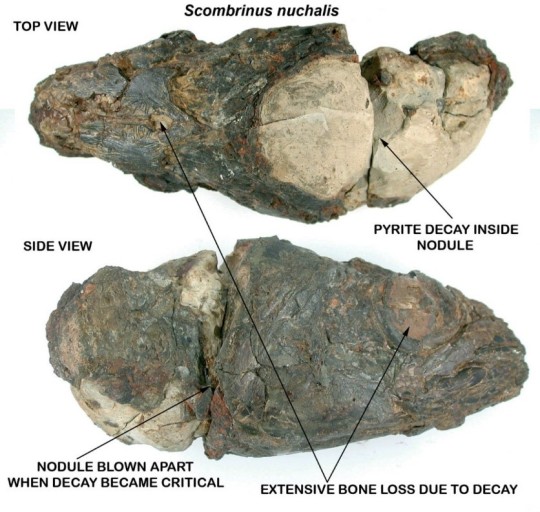
Image ID: An annotated example of a fish skull preserved in a nodule, which decayed and broke due to pyrite disease. There is a top view (top) and a side view (bottom, fish facing right). There are labels pointing to the top of the skull and to the eye socket showing cavities and red-orange rust labeled “extensive bone loss due to decay.” A white section of the nodule that is split and crumbled is labeled “pyrite decay inside nodule.” The side shows extensive decay to both the fossil and nodule, labeled “nodule blown apart when decay became critical.” End ID.
[Image by Trouble with pyrite – Deposits Mag]
One of the reasons that it is considered a disease is the progressive nature of pyrite decay, which visibly worsens over time. Another reason is the way that sulfuric acid seems to spread and contaminate even the container that the fossil is held in, leaving damage marks on the fossil and its labels. Another factor is the fact that the products of pyrite oxidation expand, appearing like mold or growths that further damage the fossil. The expansion of these oxidation products is one of the most damaging aspects of pyrite disease, as the instability in the crystal structure of the specimen causes cracking and flaking. This is because pyrite oxidation causes the conversion of iron pyrite (FeS2), an iron sulfide mineral that has a cubic crystal structure, to iron sulfate (FeSO4), which has an orthorhombic crystal structure. Not only does this cause the specimens to crack and crumble, but the cracking of the specimen causes flakes of pyrite to break off and spread. These flakes may land on other specimens, spreading the contamination of pyrite decay to other fossils that were previously stable. In many cases, museums must face difficult decisions to remove scientifically valuable specimens, or even portions of specimens, to prevent further spread of pyrite disease.

Image ID: Left: The crystal structure of iron pyrite. Right: The crystal structure of iron sulfate. End ID.
[Images by: mp-226: FeS2 (Cubic, Pa-3, 205) (materialsproject.org)]
How Can Pyrite Disease Be Managed?
Now, I’ve said that pyrite disease is unreversible. But can it be stopped from progressing once it contaminates a specimen? The simple answer is no. The more complicated answer follows:
Several factors that contribute to pyrite disease: temperature, humidity, oxygen levels, pH, exposure, crystal structure, and bacteria(3). Some factors, such as bacteria and pH, require specific conditions that are uncommon (Thiobacillus bacteria are present over 95% humidity(3) and pH is often affected by the decay process and the methods used to manage it). Other factors are closely linked (e.g., temperature and humidity).
Pyrite disease is most closely linked to humidity and high oxygen conditions. The best way to stop pyrite disease is prevention. Most museums use some form of climate control to preserve their specimens, but the issue here is that vertebrate fossils (bones) have a moderate recommended relative humidity level (~45-55%) in order to avoid cracking or warping6, while the recommended humidity level to prevent pyrite disease is 30%(7) (although below 50% is also stated by some sources(2,8)). In contrast, humidity above 60% is known to accelerate the decay, even to the point that decay begins within a few days of exposure(3, 2). This low humidity level is not always possible, especially for public display, although it is used in some invertebrate collections. Using humidity and oxygen scavengers (e.g., silica gel packets) when collecting can reduce the exposure of specimens to these factors. Using humidity and oxygen barriers when storing specimens can prevent pyrite disease(3). Contained storage of an already contaminated specimen may trap moisture with the specimen. Although, I would say it is better to have an isolated specimen that decayed than have an open specimen contaminate others.

Image ID: The unpolished appearance of a pyritized ammonite. The ammonite is held in front of a rocky area. It is a dull grey color with a matte appearance. It has lumps of rounded pyrite surrounding it. End ID.
[Image by Martin Curtis, Pyrite Decay in Fossil Collections – ZOIC PalaeoTech Limited (zoicpaleotech.com)]
Since the damage from pyrite disease is exacerbated by sulfuric acid, one of the other prevention methods used relies on acid neutralization(5), although this is less common. Currently, the use of humidity and oxygen buffers is the most common method, but some groups rely on extensive testing of specimens to determine which have unstable forms of pyrite incorporated into the fossil or matrix before acting. Another preventative method is removing salt (which may speed up the decomposition) and removing any matrix that may contain pyrite or trap moisture (e.g., clays)(5). Washing specimens to remove salts or matrix remains could damage specimens that are already unstable or could cause damaging moisture exposure (although this could be avoided by washing with alcohol).
Many studies have attempted to find effective ways to stop, reverse, or prevent pyrite decay. From acid treatments to preemptively coating specimens in resin, these tested methods were often damaging to the specimens, especially over the long term. However, were they damaging enough to be worse than pyrite disease? Not necessarily, but a combination of the damage done, the cost, the time investment, and the ineffectiveness of these treatments means that prevention is still the only reliable method for pyrite disease.
Coating specimens in resins and varnishes may provide a buffering effect, but the resin only slows oxidation, it does not stop it. This becomes an issue when the vanishes cannot be removed, and the specimen cannot be accessed for other treatment methods(2). Varnishes may delay the effects, but they have effects of their own, are usually not moisture-proof, and may yellow and crack over time. Coating with resin or embedding the fossil in resin creates the risk of an explosion as the oxidative reaction builds heat and pressure. Some museums coat their fossils in plastic glues (such as Paraloid B-67 or B-72), these glues are reversible, and B-67 is hydrophobic, unlike most resins.
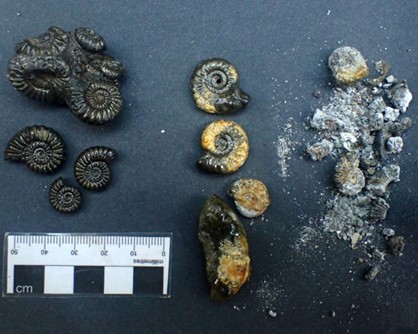
Image ID: Examples of varnished ammonite specimens, showing progressive stages of pyrite disease as the varnish aged and cracked. Left: Complete pyritized specimens with no signs of decay and a glossy finish from the varnish. Center: Pryitized specimens with patches of yellow-orange decay in sections where the varnish cracked. Right: specimens reduced to dark grey and white dust. End ID.
[Image by Chris Andrew, Pyrite Decay in Fossil Collections – ZOIC PalaeoTech Limited (zoicpaleotech.com)]
There are two “cures” to pyrite decay. However, these do not cure pyrite decay in the sense that they reverse it. Instead, these are methods to neutralize the products of pyrite disease to prevent further harm to the specimens. These two methods involve the use of ammonium gas or ethanolamine thioglycolate to remove pyrite byproducts (ammonia converts the iron sulfate to iron oxide(8)) and neutralize any generated sulfuric acid(2). Both methods are intensive, potentially hazardous, and relatively expensive. As a ‘cure,’ they are effective at temporarily halting the progression of pyrite disease, but not preventing it or reversing it. These treatments have been proven to be ineffective at preventing pyrite decay without the use of controlled microclimate (oxygen and humidity exposure)(3).
References:
1 Replacement/Recrystallization (petrifiedwoodmuseum.org)
2 Pyrite Decay in Fossil Collections – ZOIC PalaeoTech Limited (zoicpaleotech.com)
3Minerals | Free Full-Text | Pyrite Decay of Large Fossils: The Case Study of the Hall of Palms in Padova, Italy (mdpi.com)
4Pyrite Disease - Canadian Museum of Nature
5Pyrite disease (palaeo-electronica.org)
6Shells Eggs Bone and Related Materials 160229 (welshmuseumsfederation.org)
7PowerPoint Presentation (vertpaleo.org)
8Trouble with pyrite – Deposits Mag
#vpoc writes#rockposting#vpoc yells#pyrite disease#pyrite oxidation#vpoc has cool rocks#other cool rocks#long post#paleontology#geology
61 notes
·
View notes
Text


after years of not doing it, I’ve finally made a gemsona :3
idk if those pictures are different kinds of pyrite, but they’re all definitely pyrite. some are just iridescent like that.
though it’s definitely not my color, i LOVE pyrite for being able to form platonic solids. cubes are most common but these guys are a couple of octahedrons. they’re a lil special i love them.

silly guys bubby and coomer from hlvrai. please watch it. the pyrites are probably some sort of scientists i guess because these two have been living in my brain


bonus: my irl pyrite shaped into a stella octangula i love it i love it
#art#digital art#gemsona#steven universe#su gem oc#steven universe oc#hlvrai boomer#lol#pyrite#octahedron#stella octangula#platonic solids
88 notes
·
View notes
Note
pyrite propaganda: pyrite is so amazing i’m not even kidding. in my mothertongue, instead of being called fool’s gold, it’s called cat’s gold and we all love cats right?
also, fossils can become pyritised, meaning that we have literal DINOSAUR FOSSILS that are made of pyrite!!! beautiful shiny golden pyrite!!!
plus pyrite has a lot of chemically similar minerals that are awesome that it can occur with as well. i love chalcopyrite because i love copper (CuFeS2 if im not mistaken) and arsenopyrite is haha funny because its chemical composition is literally FeAsS and it has arse in the name as well (sorry).
it also forms in cubes and im p sure the other shape is a dodecahedron (sorry im not good at remembering geometry and im writing this in a pyrite-induced feverish haze so im not gonna google that rn) and we love 1. minecraft (cubes) and 2. dnd (dodecahedron)
i literally love this rock so so so much i will cry forever if it doesnt win (real)
YES TO ALL OF THIS! And thank you especially for shouting out chalcopyrite i love chalcopyrite.
60 notes
·
View notes
Note
Your rocks are really cool 😊 which are your favorite? Which are the best for hold in your hands with other rocks and clacking them around?
thank you :D my favorite is the dodecahedral pyrite, i didn't know pyrite could come in other shapes than a cube before i saw the one i now have and i was like aaaaaaa (and pyrites are already my faves in general)
the ones that are best to hold are definitely the smoother rocks that are solid enough that i don't worry about damaging them. this one is the best example cuz the way it's shaped makes me think of a dagger and it has a fun fossil on it:

i'm not really big on them making sound tho, i just like Observing them uwu
#talky talk#reply#thank you for the ask it was so sweet of you#honorable mention to the gypsum crystal: so pretty but so fragile rip#im horrible at remembering what rocks i have which is a shame but eh what can ya do#me every time i get a new rock and discard the description: yeah i'll remember#:narrators voice: ze did not
9 notes
·
View notes
Text
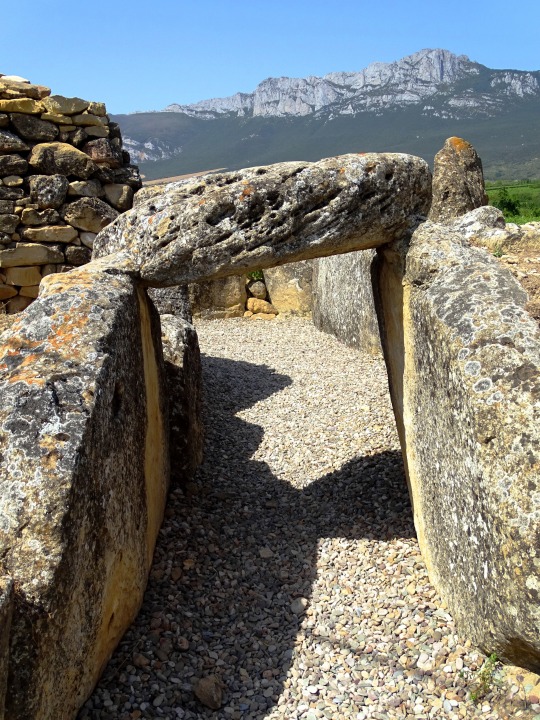




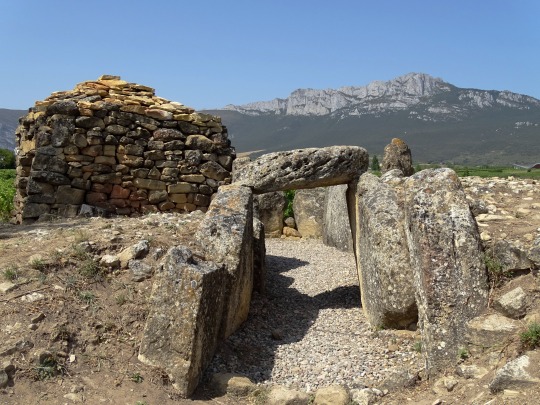
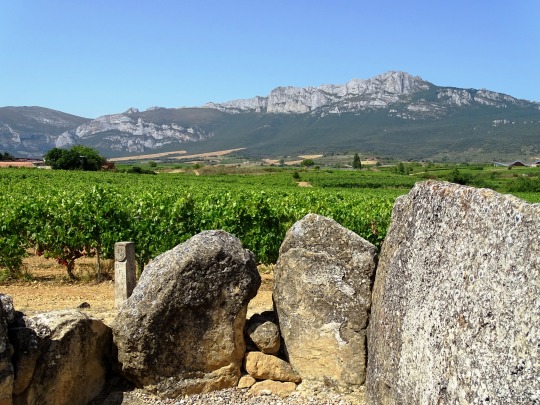

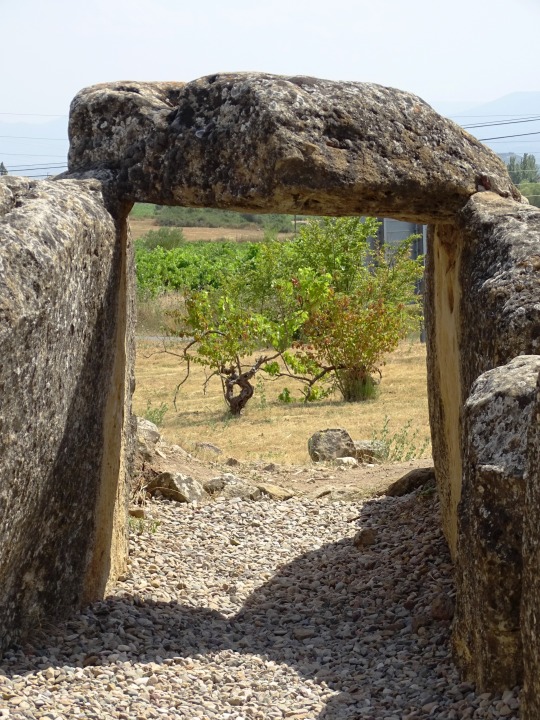
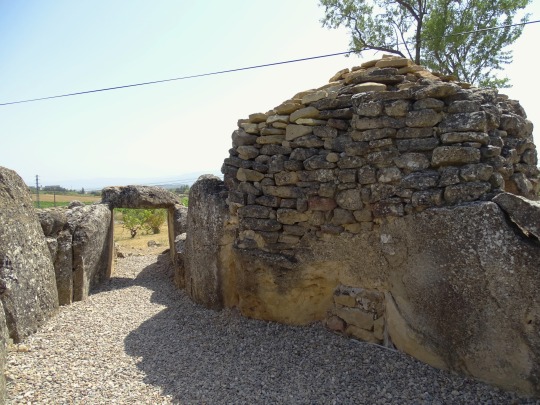
Dolmen of San Martín, Spain (No. 2)
It was located by José Miguel de Barandiaran and Domingo Fernández Medrano in April 1956 and excavated by them together with Juan María Apellániz between July and August 1964, in it several layers of stratification were detected that gave rise to a great resonance within the Spanish archaeological field. Two fallen slabs were found in the chamber that provided two different levels of occupation, one of them from the Neolithic period and the other from the Chalcolithic period.
In the first level, formed by 190 cm of earth under the fallen orthostats, remains of 21 individuals were found with their trousseau composed of typically Neolithic pieces. Two knives, two blades, thirty-two flakes, sixteen triangles, sixteen trapezoids, two scrapers, five denticulate, a perforator, a raedera, a rock crystal of great proportions carved in the form of a hoof scraper or goat's leg, five polished axes and chisels and two fragments of ophita axe, a calaite bead, were found. a rock crystal, pieces of smooth ceramics, a piece of pottery decorated with bands and six fragments of decorated bones that correspond to four spatula idols.
In the second level only the rest of an individual were exhumed and three simple sheets, two laminites and two points with marginal touch-ups, three arrowheads with peduncle and fins and the peduncle of another, three triangles, two scrapers, four denticulates, a sphere and thirty-four flakes were collected, all made in flint next to a polished axe, an ochre bar, a pyrite cube, a calaite bead, a white stone ring fragment, 14 bone buttons with "V" perforations and hemispherical in shape, a sheet and a dagger made of bronze and seven remains of bell-shaped pottery of the ciempozuelos type, one with incises and the others smooth.
Source: Wikipedia
#Dolmen of San Martín#Rioja Alavesa#Basque Country#Neolithic#archaeology#España#Southern Europe#Spanish history#Northern Spain#summer 2021#travel#original photography#vacation#tourist attraction#landmark#free admission#landscape#countryside#flora#nature#tree#burial chamber
3 notes
·
View notes
Text

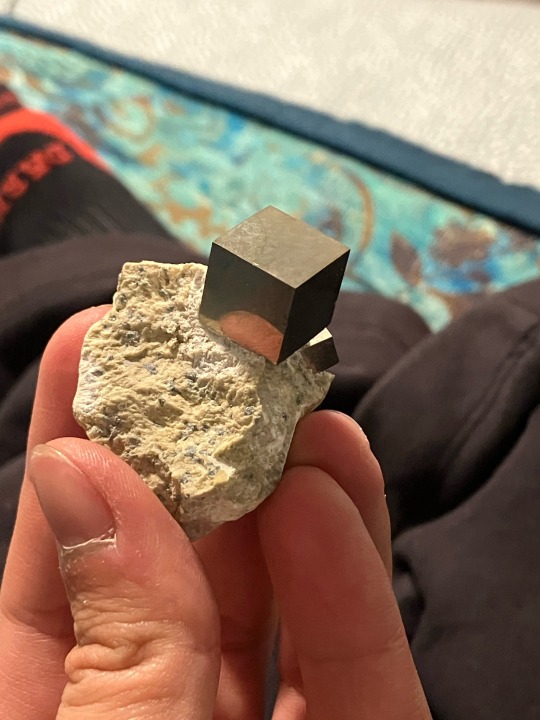
Pyrite.
An Iron sulphide. Commonly referred to as ‘fools gold’ due to its color and high density misleading novice prostectors. That said Pyrite is much lighter in weight than gold of the same size.
The sample above is Pyrite in its cubic form. Nobody has shaped this sample into these perfect cubes but rather this is one of the ways Pyrite naturally forms.
Pyrite was a common material used in art deco jewellery.
Below is another sample of Pyrite I have showing one of the other forms it can take:


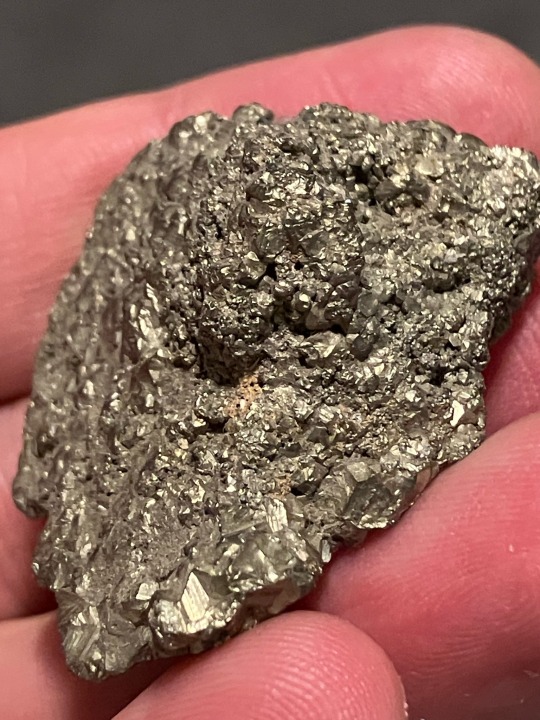
1 note
·
View note
Text
Hello askers!
I bet you're eager to learn about what's going on here! Hopefully!
This is an ask/dare blog for Tapity (tapittt)'s AU for Just Shapes and Beats; Beatrii! Curious about anything? You can ask a question to Tapity themselves! (no dares for her though, please!)
This AU has recently been revamped into something of a speculative biology project, so feel free to ask about that!
Allow me to introduce you to the characters and their personalities!
Cube (All Pronouns) - A kindhearted parental shape. They love to garden and throw parties for their friends! (Continent of origin: Paradise)
Harbor (He/Him) - A protective and courageous shape that has been modified by technology. After the events of Beatrii, he took up teaching yoga! (Continent of origin: Paradise)
Helico (She/They/It) - A headstrong shape that has also been modified by technology. She will stop for nobody and nothing to prove her worth! (Continent of origin: Paradise)
Square (He/They) - An insensitive guardian. After the events of Beatrii, he's been exiled for his corrupt reign upon Paradise. (Continent of origin: ???)
Orance (He/It) - A guardian with a makeshift bandage over his right eye. Though he used to be courageous, he is now a shut-in. (Continent of origin: ???)
Green (He/Her) - A lingering ghost of what used to be a guardian. Despite his shattering, he has still managed to preserve his kindhearted nature. (Continent of origin: ???)
Pyrite (He/They) - A guardian that got lost along his trip to Paradise and taken in by Cresc, a resident of Terra. He's jumpy, and frail. Please be nice to him. (Continent of origin: ???)
Lycan (He/Him) - A goofy shape with a good heart. Frequently pulls pranks on Cuda, his """best""" """friend""". (Continent of Origin: Paradise)
(Barra)Cuda (He/They) - A grumpy, wealthy shape. Pretends to hate Lycan's antics, but secretly enjoys it. (Continent of Origin: Tetrah)
Blixer (He/It) - A monstrous shape plagued by his corruption. He's been trying his hardest to change his ways. (You may also ask his other forms questions if you please! Please specify which one though!) (Continent of Origin: Secrecia)
Cresc (They/Them) - A looming, caring shape. They took in Pyrite and forged him a crystal leg. (Continent of Origin: Tetrah)
Pentacle (He/Him) - A nervous, passionate shape with large wings. He loves to craft and sew! (Continent of Origin: Lachyri)
Moon (It/Its) - A retired guardian from the last corruption with a shimmering silver color. It sports many scars and stories. (Continent of Origin: ???)
Cloven (She/It) An old, large, corrupted monster who's color has began to fade. Blixer's great grandmother. She, too, has brought upon the corruption to the world of Beatrii. (Continent of Origin: Secrecia)
Quadran (She/Her) - Also quite an old shape. She has multiple scars on her face, and is Cube's great grandmother. She experienced Cloven's corruption, though they still talk as friends now and again. (Continent of Origin: Paradise)
Sunny (She/Her) - The priestess of Paradise! She's quite tall, and loves to take care of things; so she works in the Paradise daycare on occasion. (Continent of Origin: Oasin)
Vega (She/Her) - Sunny's adoptive daughter, and one of Cube's childhood friends. She helps her mother with her jobs sometimes! It makes her feel helpful. (Continent of Origin: Paradise)
Snare (He/Him) - Cube's older brother! Affectionate and, well, brotherly! He loves to paint and play the guitar. (Continent of Origin: Paradise)
Audun (He/They) - A wiry shape sporting multiple facial scars. Used to be in a gang of sorts... and probably still is. He's okay though. (Continent of Origin: Oasin)
Sorry for the long text! Have fun asking!
EDIT: YouTube dubs/compilations are very welcomed as long as you provide proper credit to the art and blog (preferably in the video AND description)! I'd love to hear all of your takes on the characters!!
-Tapity
3 notes
·
View notes
Photo

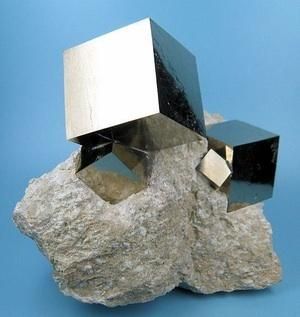


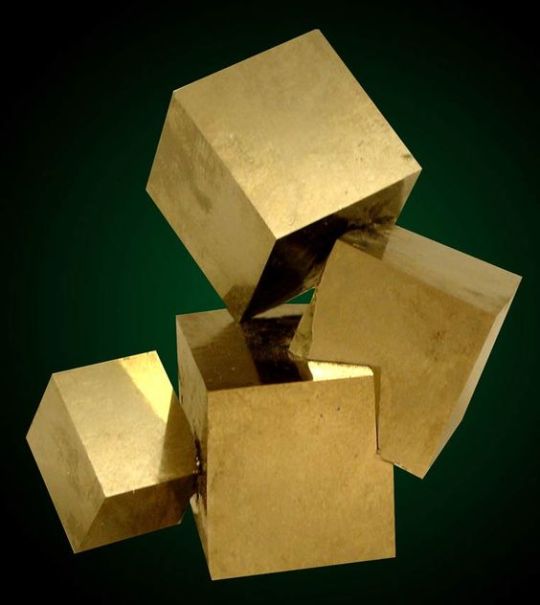

Pyrite
---
(images not mine, if you need something removed inbox me & it will be)
14 notes
·
View notes
Note
*Vibes next to Cuda* 🔆This place seems pretty crowded!! ^^🔆

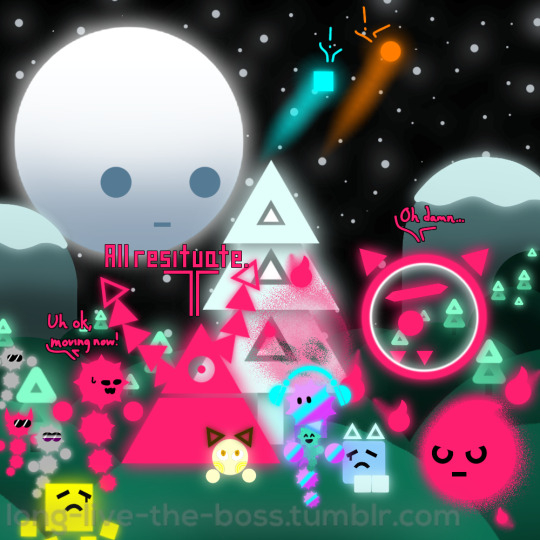
Macabre: "The snakes? Are they necessary?!"
| Barracuda: "Wherefore do you say they were not?"
Macabre just rolls his eyes...
| Barracuda: "Anyway, what was our task at hand? I seem to have forgotten."
#just shapes and beats#jsab player#jsab square#jsab circle#jsab cube#jsab boss#jsab fresh#jsab barracuda#jsab lycanthropy#jsab la danse macabre#jsab moon#askblog#hopeful pyrite
8 notes
·
View notes
Text
Identifying Crystals
What makes each crystal unique and special is its dynamic composition, which is made up of highly structured patterns of molecules called lattices. As their pattern repeats itself over and over again, shapes and facets with particular types of symmetry are created. In stone identification, crystals are categorized into several types of shapes, which influence their aesthetic and energetic properties.
Crystals such as Pyrite, Diamonds, and Fluorite are cubic lattices created from three equal axes formed into a cube. The balanced structure gives these types of stones a naturally harmonious energy that magnifies everything around it. Crystals can also be hexagonal, like Emerald and Aquamarine, which are shaped in four axes of six-sided symmetry.
Other crystals such as Apophyllite and Zircon are tetragonal, a shape that resembles two four-side pyramids joined at the base. Some crystals aren’t as highly uniformed. In the mineral kingdom, orthorhombic crystals have three unequal axes that form an elongated spear, like Peridot and Topaz. The most asymmetrical of crystal shapes are the triclinic kind like Labradorite and Turquoise while trigonal crystals have an elongated lozenge shape.
Colors are another common crystal identification method. In fact, many gemstone experts classify crystals according to color because of its link with specific healing properties. The color blue, for instance, has a gentle and soothing quality while red is associated with passion and desire. In the gemstone world, colors are also linked with certain types of crystals and how they are used for specific chakras, which are designated energy centers in the body.
Crystal identification by color can be challenging for some crystals like Calcite, Fluorite, and Tourmaline, among others, since they come in different colors. In that case, you should refer to a crystal book or directory that categorizes by color and includes a photo of the specimen. Here is a list of the most widely available crystals to point you in the right direction.
Black – Associated with power, protection, and mystery, commonly available black gemstones include Black Obsidian, Black Tourmaline, Hematite, Jet, and Onyx.
Blue – A tranquil and relaxing color, blue crystals are excellent for emotional and physical balancing. Commonly found crystals in this category are Angelite, Aquamarine, Celestite, and Lapis Lazuli. Blue crystals also include Blue Lace Agate, Apatite, Azurite, Blue Chalcedony, and Chrysocolla.
Brown – Associated with the earth and the trees, brown stones help to absorb negative energy. Harness the earthy healing vibes of brown gemstones with Smoky Quartz, Brown Jasper, Bronzite, Petrified Wood, and Tiger’s Eye.
Yellow and Gold – The color of the sun at full midday strength, yellow and gold colored stones represent optimism and joy. Bring a little sunshine into your life with Golden Topaz, Citrine, Amber, Yellow Tiger’s Eye, and Yellow Jasper. Gold stones are also a symbol of wealth and power such as Pyrite and Gold.
Green – Activate and clear your heart chakra with green stones, which have a healing and balancing effect on the emotions. Bring good fortune and prosperity into your life with Emerald, Aventurine, Green Fluorite, Jade, and Malachite, the lucky charms of the mineral kingdom.
Orange – A power color, orange stones awaken the passion within the spirit. Capture the spirit of the sun with Orange Calcite, Aragonite, Carnelian, Sunstone, and Copper.
Pink – The color of love and compassion, pink stones like Rose Quartz and Rhodochrosite are big-time heart energizers and openers. Other pink stones include Lepidolite, Pink Tourmaline, and Pink Sapphire.
Grey – The color of moonlight, gray or silver stones reflect the expansiveness of the universe, which gives them protective warrior-like qualities. Gray stones like Hematite and Moonstone have a silvery finish that evokes a starry night sky, a subtle yet powerful influx of light that helps to cleanse the spirit.
Purple – The color of enlightenment and intuition, purple stones like Amethyst and Charoite have a magical luster. They also help balance the emotions with relaxing and soothing vibes. The crystalline structure of purple stones makes them powerful energy amplifiers, especially when combined with other heart chakra stones.
Red – The color of passion and life force energy, red stones like Garnet, Ruby, and Red Tiger’s Eye have a warming and grounding energy that helps support the root chakra.
White – Representing purity and transformation, white stones like Selenite and Clear Quartz make excellent healing tools, especially when incorporated into healing layouts.
When you combine astrology with crystals, it has the potential to take your inner wisdom to a whole new energetic level. As Socrates put it, “To know thyself is the beginning of wisdom,” and the beaming diamonds in the sky can give you insight into your deep inner workings, especially in combination with certain crystals. In the ultimate energy cocktail, try out these crystals for your astrological sign and let it guide you on your epic journey.
Aries – Complement the fiery and passionate nature of the Aries with Carnelian, a bright orange sun stone that boosts creativity and blocks negative vibes. Citrine enhances the creative and ambitious Aries with its ability to increase clarity of thought and purpose.
Pisces – A water sign like Pisces should try pairing up with Aquamarine, which stimulates the heart chakra. For the sensitive Pisces, Chrysocolla rocks at soothing heartache because it encourages the expression of emotions. Amethyst also helps rejuvenate the spirit.
Aquarius – A sociable air sign, Aquarians should rock out with Aquamarine, a stone that boosts the community spirit by encouraging clear and effective communication. The stubborn nature of the Aquarius can also benefit from Yellow Jasper, which helps heal old emotional wounds that are blocking the heart chakra.
Capricorn – This ambitious and determined sign needs energy that boosts the life force, like Garnet, a red stone that invigorates the root chakra. The ethereal quality of Azurite also helps balance the sometimes overly practical and conservative nature of Capricorns.
Sagittarius – The curious mind of the Sagittarian could use a little Bronzite in their lives, especially for its energizing energy that encourages spiritual transformations. The grounding and stabilizing energy of Citrine helps the on the go Sagittarius signs to reconnect with their roots.
Scorpio – The most moody and unpredictable sign in the zodiac, Scorpios need calming stones like Amethyst to balance emotions. Malachite also helps speed up emotional healing while Citrine brings a boost of joy and light into the heart chakra.
Libra – Lapis Lazuli helps with decision making, which helps Libra signs stay focused when pulled in many directions. Libras strive for piece and harmony, which is why Citrine is beneficial—it adds a ray of sunshine and optimism to the spirit. Labradorite also helps protect the sensitive Libra from energy vampires and dream killers.
Virgo – The intelligent and detail-oriented Virgo gets a boost of confidence and determination from Red Jasper, which has a strong stabilizing and grounding effect on the root chakra. They also have a tendency to be overly critical, either of themselves or people in their lives, and Kyanite helps balance these negative impulses. The good luck charm of gemstones, Jade brings abundance and prosperity, which enhances Virgos and their go-getter attitude towards life.
Leo –The proud lion loves to be in the spotlight, which is why Garnet is an excellent stone. It ignites the fiery passion within the heart of the ambitious Leo. Tiger’s Eye manifests feelings of confidence and inner strength while Carnelian boosts creativity and personal power.
Cancer –The dreamy and magical Moonstone helps to bring out the sensitive and intuitive nature of the Cancer sign. Red Jasper also supports the emotional and sensitive Cancer by boosting endurance and stamina. Abalone Shell reconnects the loving and nurturing Cancer with the tides of the ocean.
Gemini –The properties of Rutilated Quartz help keep the dynamic personality of the Gemini in balance by connecting them to their higher selves. A powerful creativity booster, Carnelian supports the fun-loving nature of the Gemini and their need for personal expression. A heart chakra stone, Jade brings harmony to the mind and emotions, which have the tendency to quickly go from serious to happy-go-lucky.
Taurus – Pyrite brings abundance and prosperity, which complements the practical side of the Taurus sign. They are also ambitious and sensual, which makes the Carnelian an excellent stone for its confidence-boosting properties. A stone of personal power, Peridot helps Taurus go after their heart’s desire.
Gemstones are also associated with chakras, which are specific energy centers in the body. There are seven chakras and each one is linked with certain emotions, which is why crystals are effective in clearing and activating these energetic pathways.
Crown Chakra – Located at the top of the head, the crown chakra is where enlightenment and transcendence occurs. For those crowning, life-affirming moments, purple stones like Amethyst are excellent spiritual companions. Also supportive of the crown chakra are white stones such as Selenite and Clear Quartz.
Third Eye – Situated in the center of the eyebrows, the third eye is associated with intuition and the wisdom of the higher self. Indigo colored gemstones like Lapis Lazuli, Sodalite, and Fluorite help to reawaken creative inspiration by opening the door of inner wisdom.
Throat Chakra – The energy center of the throat supports clear and effective communication, which makes it a popular stone for using in necklaces. When blue stones like Lapis Lazuli and Aquamarine touch the skin, it helps to balance the throat chakra by enhancing self-expression, the language of the soul. Other stones like Angelite, Sodalite, and Blue Apatite are also associated with the throat chakra, giving you the support and energy you need to speak the truth with loving communication.
Heart Chakra – When this energy center is activated and cleansed, the energetic body will begin to radiate love of all kinds. This positive, light-filled energy will attract positive influences into your life and strengthen the relationships you already have. For heart chakra healing, inspire feelings of love and compassion with Rose Quartz, Aventurine, and Rhodonite.
Solar Plexus Chakra –Yellow gemstones are excellent for balancing the solar plexus chakra thanks to bright and cheerful colors that encourage optimism and motivation. Be focused and confident because with Citrine, Yellow Jasper, Rutilated Quartz, and Pyrite by your side, you can be successful at whatever you set out to do.
Sacral Chakra – An unbalanced sacral chakra can make you feel depressed or lethargic. Alternatively, if this energy center is overactive, you could be overemotional. Bring it all into balance with Carnelian, Orange Calcite, Tiger’s Eye, and Sunstone, the gemstones of inspiration, excitement, and motivation.
Root Chakra – Always feel grounded and anchored to the earth with root chakra stones like Red Garnet, Red Jasper, Smoky Quartz, Black Onyx, and Hematite. Wear it on the skin as jewelry or keep it throughout home and you’ll begin to notice a renewed sense of confidence.
Multiple crystals can relate to one another in some way, so you can use different crystals to amplify one spell with the same intention! It’s all about your intentions and what you want to get out of the crystals and spells. Each crystal should be given a purpose. The next Unit will cover how you can do just that!
#chakra#healing#crystal#stone#crystals#stones#wicca#witchcraft#witchcraft community#babywitch#baby witch#rockymountainwitch#rocky mountain witch#rmwitch
138 notes
·
View notes
Text
I’m back from my rock show! Who wants to see all my new Cool Rocks?

This little guy is red corundum, also known as a ruby! It naturally grows in that hexagonal shape. Here’s a fun rock fact: if this corundum was any other color, it would be called a sapphire!

I’ve gotta get some sunlight shining on this one. It’s the only way to properly appreciate rutilated quartz! This super clear quartz has a whole forest of golden needles of rutile growing inside! The only bad thing about rutilated quartz is that photos don’t do justice to how sparkly and golden and amazing it really is.

This is half of what’s called a pyrite sun! Pyrite’s known for its cube-shaped crystals, but did you know it can form in flat round disks like this too? They’re also called sun dollars, and pretty much the only place in the world where they occur is my home state of Illinois!
I won this rock at the show’s silent auction, and somebody else went home with the other half of the disk. It’s cool to think that somewhere out there, someone has the other half of my rock.

Here’s some more pyrite! These pyrite crystals didn’t form in the usual cube shape either. They’re slightly rarer dodecahedral crystals! Those pointy white crystals growing around them are a mixture of calcite and dolomite. The other cool thing about this specimen is the beautiful bronzy reddish color of the pyrite, which was probably caused by oxidation, the pyrite chemically reacting with oxygen.

Opal! Opal opal opal!! It’s about the same size and color as a piece of chocolate, which is fitting because this is Ethiopian chocolate opal!

The play of color is amazing against that dark background. Here are some more pictures of all the different colors in this opal. I’m particularly blown away by that blue!
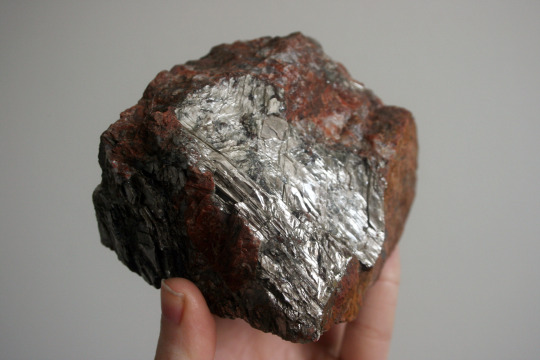
This is pegmatite, an ingneous rock. Igneous rocks are the rocks that form when molten lava cools and hardens, and pegmatites are igneous rocks which form with abnormally big crystals. Usually crystal growth happens really slowly, but the crystals in pegmatite are able to get really big because they form really fast! I didn’t wrap this rock in tinfoil. The huge shiny patch on this pegmatite is probably either molybdenite or graphite - the stuff in pencil lead!
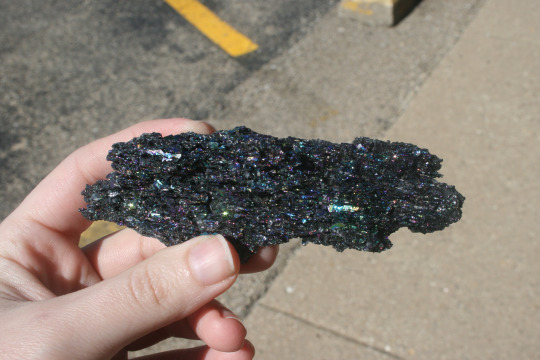
How about a manmade rock? This is silicon carbide, also known as carborundum! It’s created by heating carbon and silica and is used for all kinds of things - like an abrasive for saws and cutting tools. I own a dremel with some silicon carbide bits! Of course it also makes for an amazing iridescent gemstone.
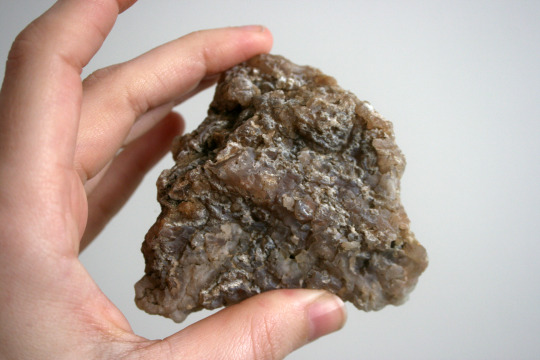
This weird looking rock is chalcedony! And it’s cool because it’s very slightly sort of technically radioactive!!! My little rock viewing light isn’t powerful enough for this kind of fluorescence, but if I had the right kind of UV light, I could show off how this guy fluoresces neon green! Green fluorescence in chalcedony is caused by uranyl ions… as in uranium!
Don’t worry, this rock isn’t radioactive enough to hurt me. Lots of quartz, jasper, and chalcedony contain tiny amounts of uranyl ions, but uranium’s actually pretty safe stuff! Even solid chunks of uranium ore are safe enough to hold in your bare hands. I got to handle some at the rock show!

This rock is full of tiny, hollow pockets lined with green crystals of epidote. Epidote has some Cool Optical Properties, but these crystals are much too small to show them off. Supposedly, large crystals of epidote change color depending on the angle you view them! But this rock has sparkly green spots, and that’s enough to file it under Rocks That Make Me Happy!

Speaking of green rocks, this is pyromorphite! I’d never even heard of this rock before going to the rock show, but it’s my favorite color, so this is my new favorite rock! Here’s all the Cool Science I’ve been learning about it.
This specimen came from Daoping Mine in China, which produces some really large, beautiful crystals of this stuff! Pyromorphite is a type of apatite, so it’s like the sister of the blue and yellow apatite specimens I already own. It’s a lead ore, so if I ate it, I’d be super dead! Pyromorphite can actually form in the soil of industrial areas which are polluted with large amounts of lead. Some scientific studies have been done about maybe using that transformation of lead into pyromorphite as a way of cleaning up polluted soil by making the lead safer and less water soluble. But it turns out that’s not a good solution, because there’s a species of fungus that likes to turn pyromorphite back into lead! That fungus is black mold, the same stuff that makes you super sick if it starts growing in your house. Geeze black mold, why are you so terrible in literally every context?
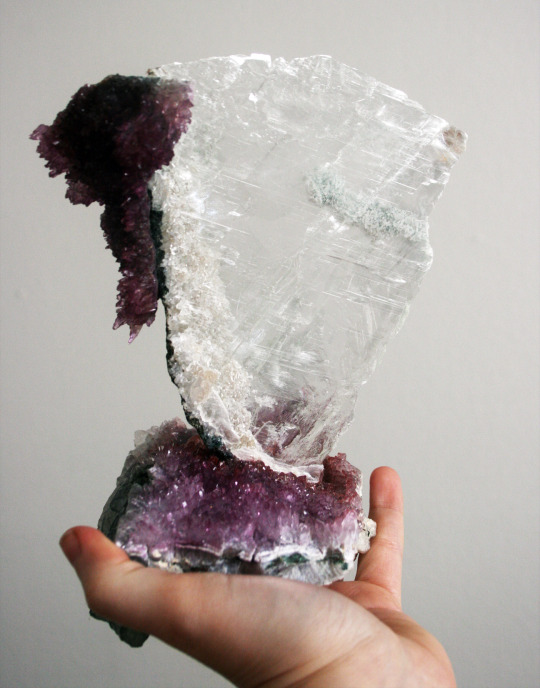
Big sparkly girl! Big sparkly girl!! This is probably the second best rock I came home with. It’s a big plate of selenite with a bunch of interesting inclusions. (And I cannot resist interesting inclusions.) It didn’t grow out of that piece of quartz; that’s actually its display stand! This Cool Rock is a conglomerate of several different rocks held together by resin - it’s an art piece! The quartz has been dyed purple to made the colorless selenite really stand out against it. If you don’t like manmade rocks, cool displays like this are probably not for you, but I think it’s a neat way of showing off a rock! Sort of like a little rock statue for my apartment.
But now for the best rock…

Big fossil boy! Massive fossil boy!! Absolutely enormous fossil boy!!!

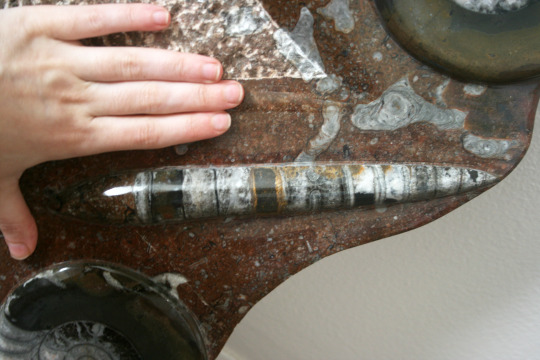
Here is my unreasonably large pianist’s hand for scale. These fossils are huge! Those long cones are the skeletons of orthoconic nautiloids, but you might have also heard of them as orthoceras. They were big cone-shaped cephalopods! They’re found all over the world and actually belong to a whole bunch of different species, though scientists didn’t realize that for a long time and just called them all orthoceras. I’m not sure if the spiral fossils are nautiloids or ammonoids. You’re supposed to be able to tell from the shape of the shell. Nautiloids, maybe?
What a cool find! Nothing is better than coming home from a rock show with a bunch of new rocks! There’s only one problem now.

I’m gonna need another bookshelf.
2K notes
·
View notes
Photo

Remember that Pyrite I drew in that sketch a year or two ago? Well, we’re going to scrap that concept in favor of this Pyrite!
Feature-wise, pyrites are pretty similar to golds - they have the same body type, same head shape, same eyes and mouth, etc. However, pyrites have cube-shaped gems and hair, and they can’t fly. They’re also duller in color.
Pyrites are masters of deception, often shapeshifting into another gem or creating illusions to mislead a gem or simulate a certain situation. Therefore, they can serve a multitude of purposes. Most commonly they’re used to spy on gems and rat out gems with rebellious intentions. However, they can also be used for training by projecting certain situations, or, even worse, for torture. When Era 2 came into fruition, pyrites became much rarer because of the resource shortage, and therefore, most pyrites are Era 1 gems. Era 2 pyrites are not used for spying missions, but they are used for the other purposes.
And that’s why pyrites are sometimes called “fool’s gold.” Because you’d have to be a fool to rebel against the empire.
#steven universe#su art#su gem#su gem oc#gem oc#gemsona#pyrite#art#my art#mine#oc#fan character#my fan character#concept
13 notes
·
View notes
Text
Mineral Swag Round 2: Please Don't Disappoint Me


So I understand the allure of torbernite, the uranium ore. But hear me out here. Pyrite is so much cooler.
Torbernite crushed asbestos pretty thoroughly in round one, which I understand, although I did think asbestos would put up more of a fight. It's so soft looking. Anyway, aside from being radioactive, what does Torbernite have? It's a cool green color? Okay, it'll also kill you. You can't even have your own hand sample of it :(
Pyrite would never kill you. It did kill gold last round (as it should, it's so much cooler than gold), but it really is just a cool cube shaped iron mineral! It's a greenish gold metallic mineral that naturally forms cubes or octahedra. And those cube FACES. Look how perfect they are! You can literally see your reflection in them! Sometimes they have striations (lines on the faces) but that doesn't even take away from how cool they are! Because the striations show how the mineral was growing, which is still cool. Pyrite is Fool's Gold. You can find it anywhere. It's super cheap and fun and even getting a little cube of pyrite is not expensive.
36 notes
·
View notes